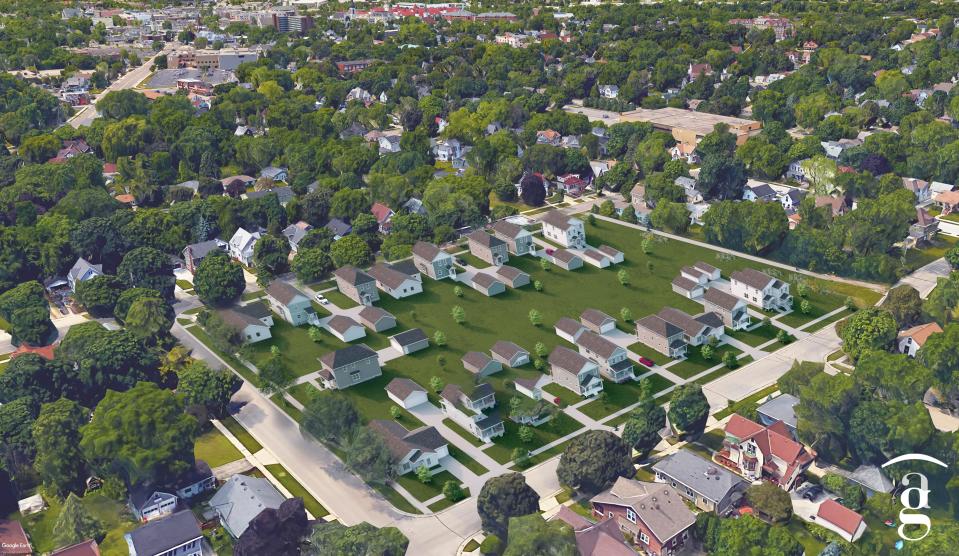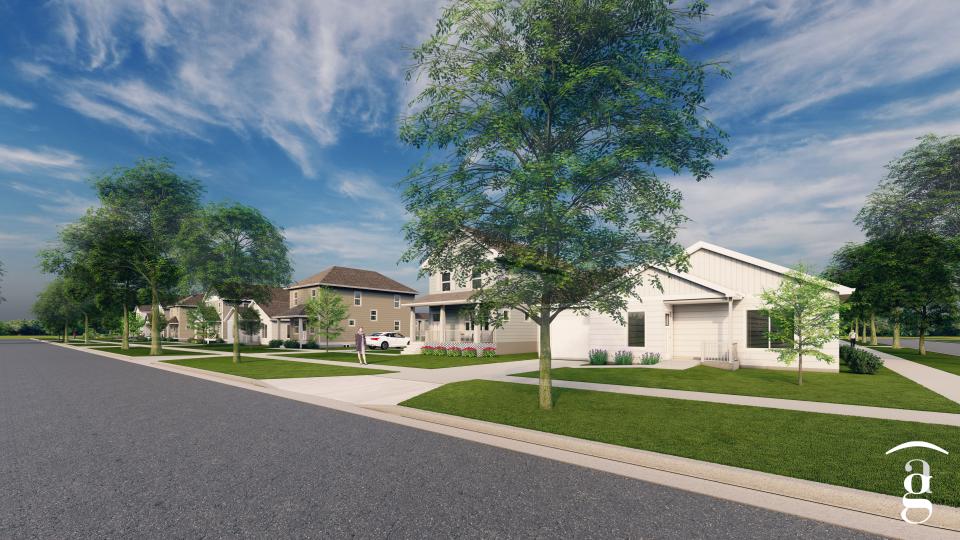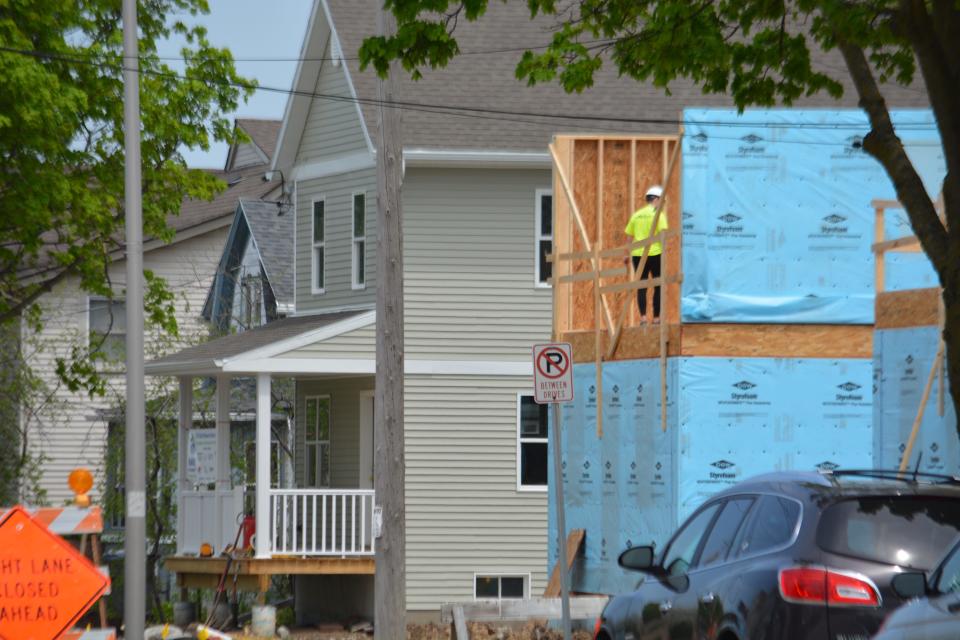For the first time, Habitat for Humanity of Waukesha County is developing its own low-income housing project
WAUKESHA - The land looks like nothing special, essentially a large square lot of grass mostly surrounded by older homes. But looks can be deceiving.
The 3.77 acres, bounded by Oakland Avenue, Ellis Street and Greenfield Avenue, in central Waukesha represents Habitat for Humanity of Waukesha County's biggest step forward, a developable parcel suitable for 18 homes, all owned by families or individuals on tight incomes who might not otherwise afford single-family residences.
For the first time, the nonprofit, also known as Habitat Waukesha, finds itself serving in the role of a developer, far different than its traditional role of building homes in scattered fashion — and, as part of the process, even converting a former industrial property once owned by Aeroshade Inc. into a residential development.
It's envisioned as a three-year endeavor, matching buyers who take a hands-on role in the construction process as part of Habitat Waukesha's unique program that also involves volunteer builders.
"It is the largest one-site development in Habitat Waukesha's history," said Melissa Songco, chief executive officer for the organization's Waukesha County branch. "The reason why Aeroshade is especially attractive to us is that it can be a more strategic, longer-term project where we know what we are going to be doing, what we are going to be building for the next three years."
Songco noted that Habitat Waukesha is no stranger to the city of Waukesha, where most of its homes have been built as part of its mission. In all, 43 have been built locally, occasionally clustered into a neighborhood.
But 18 all in one square block? That's new territory.

The project is a major shift for Habitat for Humanity
Still, it's a work in progress, partly because of how new such an effort is for an organization that usually finds individual open lots or homes to renovate.
The land was previously home to Aeroshade, a century-old window treatment company that operated a nondescript factory there until it closed in 2015. The factory, at 433 N. Oakland Ave., was demolished in 2017, leaving an open field that was put on the market for residential development.
Waukesha city officials anticipated a developer would step forward with a proposal to build a residential subdivision. That didn't happen.
By December 2021, when Habitat for Humanity's board of directors authorized Songco to submit an offer to purchase, it became clear other developers simply were lukewarm on the idea of single-family homes, as the updated zoning for the property favored.
That was all well and fine, except for the fact that Habitat for Humanity's history of reusing existing city lots, complete with all the infrastructure already in place, left it unprepared to transform the Aeroshade property on its own.
"At Habitat for Humanity, we're really good at building homes with volunteers," Songco said. "We're not so good at putting in pipes and utilities and getting the site ready — developing the track of land."

She was introduced to Jim Tarantino, the founder and principal partner in Capri Communities, a business known for its senior living facilities regionally, and a sister firm, Tarantino Companies. More importantly, Tarantino is very much an experienced developer.
Songco said Tarantino was willing to serve as the practical developer in those areas outside the usual scope of Habitat Waukesha's homebuilding routine, even offering technical assistance. She thinks she understands why.
"Jim is a great community guy and big advocate for Waukesha," Songco said, adding that his company also is providing upfront financing to help the organization close on the sale.
At this point, however, it's not a done deal.
"We don't actually own the property yet," Songco said, noting that the due diligence period for backing up the offer ends July 1. "Right now, we're going through the process of getting all the approvals we need, doing the fundraising for both private and public support and making sure everything lines up."
The plan has received preliminary support from the city for a planned urban development that includes two duplexes among the single-family residences.
Who's eligible for a Habitat for Humanity home?
It may not be an easy mission, but Habitat for Humanity keeps an eye on why it is doing it in the first place.
As measured by numbers, each Habitat for Humanity homeowner earns only 30% to 80% of the area's median income.
For instance, according to Habitat Waukesha's website, a single individual must earn no less than about $26,000 and no more than about $47,000, based on 2020-21 median income data, to be eligible for help from the nonprofit. For a family of four, the range would be about $38,000 to $68,000.
There are other qualifying factors, including the ability to dedicate 30% of gross monthly household income to the eventual mortgage.
And, most famously, is the "sweat equity" provision. Would-be homeowners must be willing to complete 250 hours by attending classes and workshops, working at the Habitat ReStore, participating in Habitat or ReStore events, and getting involved with the construction of their homes as well as the homes of others.
The organization's mission also dovetailed nicely with a city initiative discussed in recent years to increase its stock of affordable housing in Waukesha. The city included the need for such housing among needs addressed in a housing survey and study four years ago.
For Stephanie Morrison, a single mom of three children who is in line for one of the homes on the Aeroshade property, even the question of what Habitat Waukesha's program means to her emits tears.
"Sorry, I get emotional about it," Morrison said through the tears. "This, for me and my three kids and being a single parent, is like a dream I didn't think I would be able to give them. And it's an amazing program to help anyone and everyone. It's a great thing that they do."
She learned about what could be an opportunity for her family from a co-worker, who owned a Habitat for Humanity home in Milwaukee County. Eventually, she looked into it, but fretted about her credit history. Her first application did not land her a Habitat home, but found out in March that her renewed application made her eligible for a home, if the Aeroshade deal comes to fruition.
Habitat has already built dozens of homes in Waukesha
While the Aeroshade land would mark a new phase in Habitat for Humanity's efforts, the organization has already built 43 homes in Waukesha, including some prominent old neighborhoods in the city.
Clusters of Habitat homes now stand on both White Rock Avenue and off West Avenue.
For those watching closely enough, the White Rock homes don't come as a surprise, given the frequent construction projects in recent years that have been evident to anyone driving along the busy road that leads into the heart of the city's downtown.
"We're proud of the work we have done on White Rock," Songco said.

In fact, so are city officials, who in concert with Habitat for Humanity's projects designated the entire neighborhood as a tax-incremental financing district, investing new property dollars generated by the improved properties to pay off certain debt accrued to jumpstart improvements all along White Rock.
The work on West Avenue a decade ago also involved multiple Habitat duplex homes, though not to the extent of the proposed Aeroshade project. The organization included several homes in a redevelopment led by for-profit developers on land that was once the Waukesha YWCA and aided by a $900,000 neighborhood stabilization federal grant.
Another six townhomes are being built off White Rock Avenue.
What are Habitat's long-term goals?
It's no secret real estate prices have skyrocketed in an extended era of low interest rates, and that reality has affected Habitat for Humanity's goal of bringing affordable housing to its targeted homeowner.
Habitat for Humanity usually depends on the acquisition of older homes for demolition or renovation, which means the price generally has to be low enough for the project to become feasible.
"As you can imagine, we're kind of cobbling together projects for the year, and they don't always come together at the right time, and right now it's very difficult to obtain property because everyone thinks their home is worth a lot, and in some cases that's true," Songco said. "But we don't have the resources to pay top dollar for land."
That's another reason the Aeroshade project comes at a perfect time, allowing Habitat for Humanity to build a collection of homes on now-vacant land, she added. And Habitat Waukesha won't stop there.
"Even before Aeroshade, it's kind of crazy in that I have to be thinking about what's next," Songco said. "It takes a long time for projects to come together. ... In about 10 years, we want to be building 20 homes a year, doing 30 repairs a year in three communities."
The effort would hopefully put Habitat homes in places outside the city of Waukesha, furthering the organization's reach, she said.
Contact Jim Riccioli at (262) 446-6635 or james.riccioli@jrn.com. Follow him on Twitter at @jariccioli.
THANK YOU: Subscribers' support makes this work possible. Help us share the knowledge by buying a gift subscription.
DOWNLOAD THE APP: Get the latest news, sports and more
This article originally appeared on Milwaukee Journal Sentinel: Habitat for Humanity plans to build low-income housing in Waukesha

